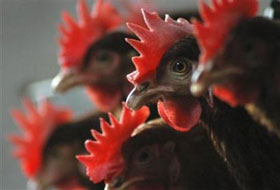中國發(fā)現(xiàn)禽流感致病基因
[ 2006-11-07 09:23 ]
|
據(jù)悉,中國研究人員已識別出一H5N1型禽流感致病基因,這項研究成果被發(fā)表在美國出版的《病毒學雜志》11月號刊上。研究人員分析了1996年從廣東省的受感染鵝身上抽取的兩種關(guān)系密切的H5N1病毒,致力于研究該病毒的基因。研究人員說:“現(xiàn)在我們知道了高致病性NS1在致病方面的特別角色,就可以考慮研制疫苗了。” |
|
|
|
 |
|
Chickens are
seen at a farm in Baokang county of Xiangfan, in central China's
Hubei province, October 31, 2006. Chinese scientists have identified
a gene in the H5N1 bird flu virus which they say is responsible for
its virulence in poultry, opening the way for new vaccines.
[Reuters] |
Chinese scientists have identified a gene in the H5N1 bird flu virus
which they say is responsible for its virulence in poultry, opening the way for
new vaccines.
There are many different strains of H5N1, some of
which kill more than half the people they infect, while others do little
or no harm.
"We can now understand how this virus becomes
lethal and the molecular basis
for its pathogenicity," Bu Zhigao at the Harbin Veterinary Research
Institute told Reuters.
The Chinese researchers zeroed in
on the virulent gene after analyzing two closely related
strains of the H5N1 obtained from infected geese in southern Guangdong
province in 1996 -- one highly pathogenic in chickens and the other
harmless.
Differences between the two strains were located in four genes, they
found.
The scientists designed four genetically modified viruses each
containing one of the four genes in question and tested them on laboratory
chickens.
Only chickens infected with the modified virus containing the
highly pathogenic gene died.
The other chickens had no signs of disease, the scientists wrote in the
November issue of the Journal of Virology.
"Now that we know the special role of the (highly pathogenic) NS1 gene,
we can think about developing a vaccine," Bu said, adding that a vaccine
which neutralizes the gene known as NS1 could be quickly designed.
"Technically, that can happen very soon, but it is the tests and other
procedures that will take a long time."
The scientists are from the Ministry of Agriculture's Animal Influenza
Laboratory, the National Key Laboratory of Veterinary Biotechnology,
Chinese Academy of Agricultural Sciences, and the Harbin Veterinary
Research Institute.
H5N1 remains largely a disease in birds although it has killed over 150
people, mostly in Asia, since 2003. Experts fear that it can spark a
pandemic and kill millions of people if it begins to transmit efficiently
among humans.
(China Daily) |
| Vocabulary:
|
| |
|
virulence: 毒性
lethal:
致命的
zero in on: 瞄準、對準、注意力集中于
highly
pathogenic gene:
高致病基因
(英語點津陳蓓編輯) | |